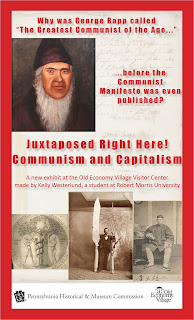Program listings for October
Today's guest blogger is Kelly Westerlund, a senior at Robert Morris University. As part of her internship work with Old Economy Village curator Sarah Buffington, Kelly researched and developed an exhibit exploring the Harmony Society's economics and business practices. The exhibit, located in the lobby of the Visitor Center, will be on view through April 30, 2015 (or perhaps longer).

With Halloween just around the corner, now is the perfect time to talk about something that frightens many Americans; that big, red monster called communism. The word for most people conjures up images of the Berlin Wall, Tiananmen Square, and children hiding under their desks to hide from nuclear fallout. It is a very scary word in American culture and has been for just about all of the twentieth century. Even now, calling someone a communist is meant to discredit them. We often think of communism as the antithesis of capitalism, but the Harmony Society proved this to be untrue in the late eighteenth through the nineteenth century. Their religious beliefs melded these two ideologies together as I demonstrate in my exhibit,
Juxtaposed Right Here! Communism and Capitalism, located in the
Old Economy Village Visitor Center.
 |
| Oil derricks at Tidioute, PA, one of the Society’s many investments (Drake Well Museum collection) |
I chose to research this topic as part of my internship with the site. I was interested in how the Harmony Society managed to provide housing, food, education, clothing and any other necessities to its members throughout its existence and still build a massive fortune. These amenities were even provided to their hired workers in addition to their normal wages. I concluded in my research that it was their religious principles that bonded communism and capitalism together. They needed to make as much money as possible to prepare for Christ’s return by operating and investing in capitalist businesses; but they also had to prepare their souls for Christ by living as equally as possible and sharing all the wealth they accumulated with each other.
 |
| Hired apple pickers (Old Economy Village collection) |
I thought I would find evidence of food shortages, rationing, and possibly even harsh working conditions like what we usually associate with communism. Instead I discovered that the Harmonists lived very comfortable lives. Even now we would envy the Harmonists! Currency did not exist within the Society so members only had to ask for whatever they needed whenever they needed it. Religion and compassion for their brothers and sisters kept them from taking more than they needed.
 |
| Store where items were distributed, 1902 (Old Economy Village collection) |
The Harmony Society’s religious, communist principles were able to flourish because they used capitalism to make their money. These ideas are not mutually exclusive to one another and neither are they big scary monsters coming to destroy our country. It is important that we clear the fog and change the way we discuss communism and capitalism. I invite you to come to Old Economy Village to check out my exhibit and learn about this amazing group that prospered with both ideologies working together.
(Editor's note 10/22: I had a brief chance to see the exhibit for myself late last week and snapped a photo.)
 |
| Visitor Center exhibit (photo by AKF) |








0 comments:
Post a Comment